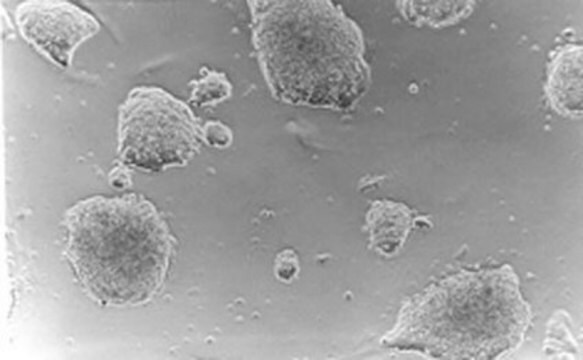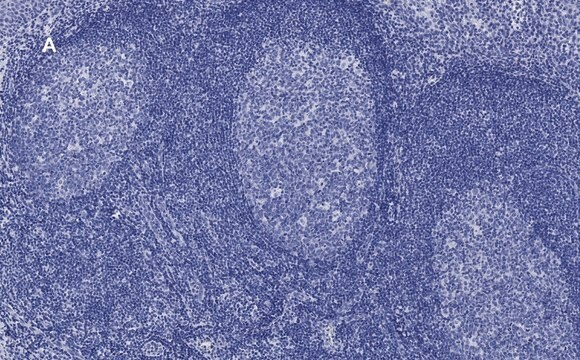推荐产品
生物源
mouse
品質等級
抗體表格
purified immunoglobulin
抗體產品種類
primary antibodies
無性繁殖
2H2.2, monoclonal
物種活性
mouse
製造商/商標名
Chemicon®
技術
ELISA: suitable
western blot: suitable
輸入
sample type hematopoietic stem cell(s)
sample type neural stem cell(s)
同型
IgG1
運輸包裝
wet ice
目標翻譯後修改
unmodified
基因資訊
human ... LIF(3976)
一般說明
Leukemia inhibitory factor, or LIF, is a pleiotropic cytokine that is expressed by a wide variety of cells including activated T lymphocytes, monocytes, mast cells and neuronal cells. Human LIF cDNA encodes a 202 amino acid precursor which is processed to yield a 180 amino acid, biologically active glycoprotein with an approximate molecular weight of 38-67 kDa. In addition to its involvement in the stimulation of acute-phase protein during inflammatory processes, LIF has also been implicated in promoting the survival and growth of axons in vitro. LIF signals through the LIF receptor, a heterodimer comprised of a 190 kDa LIFR subunit and the gp130 subunit common to the IL-6, IL-11, CNTF and OSM receptors. Janus tyrosine kinases, JAK1 and JAK2, are activated in response to LIF stimulation, which in turn phosphorylate Stat1 and Stat3 causing their nuclear translocation and the transcription of Stat-responsive genes.
特異性
This antibody is reactive to E.coli and STO derived recombinant murine Leukemia Inhibitory Factor (LIF).
免疫原
Recombinant Murine LIF.
應用
Anti-Mouse Leukemia Inhibitory Factor Antibody, clone 2H2.2 is an antibody against Mouse Leukemia Inhibitory Factor for use in ELISA & WB.
Immunoblotting: a starting dilution of 1-10 μg/mL is suggested.
EIA
Optimal working dilutions must be determined by the end user.
EIA
Optimal working dilutions must be determined by the end user.
Research Category
Stem Cell Research
Stem Cell Research
Research Sub Category
Pluripotent & Early Differentiation
Pluripotent & Early Differentiation
外觀
Format: Purified
Purified Immunoglobulin. Liquid in 0.02M PBS, 0.25M NaCl ph 7.6 with 0.1% Sodium Azide.
儲存和穩定性
Maintain refrigerated at 2-8°C in undiluted aliquots for up to 12 months from date of receipt.
分析報告
Control
Mouse DA-1a cells
Mouse DA-1a cells
其他說明
Concentration: Please refer to the Certificate of Analysis for the lot-specific concentration.
法律資訊
CHEMICON is a registered trademark of Merck KGaA, Darmstadt, Germany
免責聲明
Unless otherwise stated in our catalog or other company documentation accompanying the product(s), our products are intended for research use only and are not to be used for any other purpose, which includes but is not limited to, unauthorized commercial uses, in vitro diagnostic uses, ex vivo or in vivo therapeutic uses or any type of consumption or application to humans or animals.
未找到合适的产品?
试试我们的产品选型工具.
儲存類別代碼
10 - Combustible liquids
水污染物質分類(WGK)
WGK 2
閃點(°F)
Not applicable
閃點(°C)
Not applicable
D Vogiagis et al.
The Journal of endocrinology, 160(2), 181-190 (1999-01-30)
Leukaemia inhibitory factor (LIF) is a pleiotrophic cytokine required for blastocyst implantation in mice. Uterine expression of LIF and that of its receptors has been demonstrated in a number of mammalian species indicating that LIF may have widespread importance in
S G Ren et al.
The Journal of clinical endocrinology and metabolism, 84(8), 2883-2887 (1999-08-12)
Several cytokines regulate thyroid function and may be involved in the pathogenesis of thyroid disorders, including euthyroid sick syndrome. Leukemia inhibitory factor (LIF), a neuroimmune pleiotropic cytokine, was measured to assess its role in hypothalamic-pituitary-thyroid function. Mean circulating serum LIF
K Kami et al.
Muscle & nerve, 22(11), 1576-1586 (1999-10-08)
Using in situ hybridization histochemistry, we characterized the spatiotemporal gene expression patterns of leukemia inhibitory factor (LIF) and glial cell line-derived neurotrophic factor (GDNF), and their receptor components (LIFR, GFR-alpha1, RET) induced in muscle cells, intramuscular nerves, and motoneurons in
M K Carpenter et al.
Experimental neurology, 158(2), 265-278 (1999-07-23)
The isolation and expansion of human neural progenitor cells have important potential clinical applications, because these cells may be used as graft material in cell therapies to regenerate tissue and/or function in patients with central nervous system (CNS) disorders. This
我们的科学家团队拥有各种研究领域经验,包括生命科学、材料科学、化学合成、色谱、分析及许多其他领域.
联系技术服务部门








